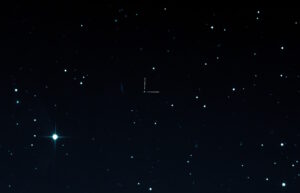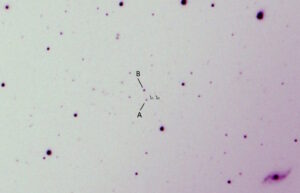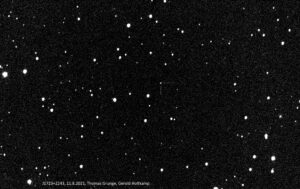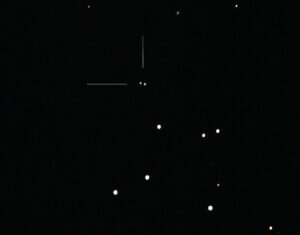Quasars are extremely luminous objects in the universe that are located at the center of galaxies. They consist of a supermassive black hole surrounded by a rotating disk of hot gas and dust. Due to the enormous release of energy, quasars are among the most distant objects in the universe that can still be detected from Earth. The huge distances and thus the deep look into the past of the universe are what make it so appealing to us. Their intense glow allows scientists to learn more about the evolution of galaxies and the early universe.
- TON 618 – the giantOn April 26, 2025, I took a photograph showing an area on the border between the constellation Canes Venatici and the constellation Coma Berenices. It's probably the most unspectacular photograph I've ever taken. However, among the recognizable stars and objects is my personal record holder.
- Mirage in the SkyThe observation of the three quasars Q0957+561, RXJ0921+4529, and SDSS J1029+2623 is described. In these cases, multiple images are generated by galaxies or galaxy clusters in the foreground, which act as gravitational lenses. It is shown that these images can be resolved even at an urban observation site.
- Observation of the quasars QSO J 1723+2243 and SPIT J17210+6017The observation of two very distant quasars is described. These are extremely faint objects that can only be imaged with powerful telescopes. A very light-sensitive camera is also required.
- The Twin Quasar QSO 0957+561ABThe moon had already risen at night at 10:30 p.m. CET on March 2, 2021, but was still low on the horizon. With 83% illuminated pane, it would soon become a fairly bright "lantern". But the author was not deterred by this.
- Quasar J0209+0517The image of the quasar J0209+0517 is described. At first, nothing can be seen on individual shots. The addition of several shots brings the desired success.
- Almost at the "edge of the universe" – the quasar QSO J0831+5245Thomas Grunge and Gerold Holtkamp imaged the quasar QSO J0831+5245 on May 14th 2020 with the Cassegrain telescope (60 cm mirror diameter, 746 cm focal length) of the NVO Observatory. Its speed alone is record-breaking: 276,000 km/s (according to Simbad). Its light was about 12.05 billion (!) light years on its way until it reaches us on Earth.





